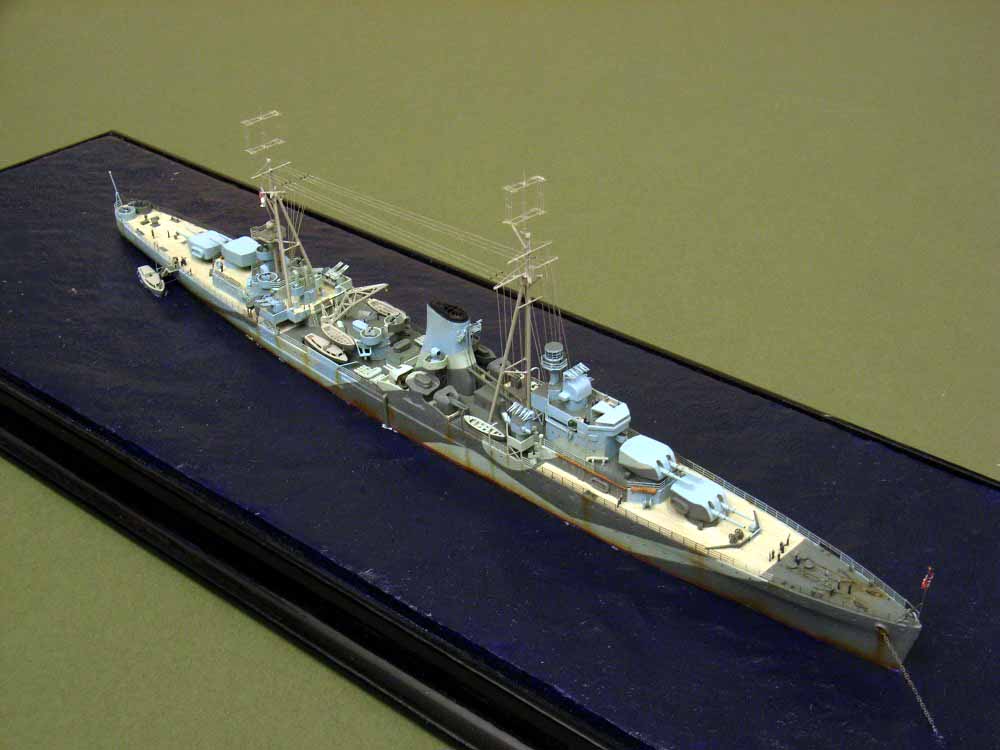by John Lingwood

1/600 HMS Ajax (Airfix)

Immediately you hear the word HMS Ajax and almost automatically one brings to mind the battle of the River Plate, and it is indeed for that action that she is chiefly remembered along with Achilles and Exeter under Commodore Harwood, however her war career continued long after that, culminating with her bombarding German positions on D Day in company with another equally famous name from the battle of North Cape, one HMS Belfast.
It was at Telford, some three years ago now, and my first visit there as a refugee from railway modelling that I came across White Ensign Models. As an ex deep blue water man I was entranced not just by the beauty of the models on display but by the detail therein. I was already to part with hard earned beer vouchers to build one, but good advice from Peter Hall stayed my hand. So I ended up building a flat top with a fairly limited amount of etch, but enough to get some practice in with impossibly thin and tiny pieces of etch brass. Whilst building Yorktown-less said the better- I came across a photograph on the RNís own web site of Ajax, in camouflage, and looking totally different from most of the photoís I had seen of her. Hooked?, you bet I was, and so began a two and a half year project.
The kit is of course the venerable and ancient Airfix kit, but taking advice from a railway modeller of some renown that one should always view a kit as raw material with which to build a model, I began. Plans from Sambrooke Marine, and photos gleaned from several sources provided the basis for construction to begin.
The hull has negative sheer aft which was dealt with by cutting the hull vertically, and then filling to get something like the proper line. I remember not modifying the main deck, but from there on in it was mostly a case of chuck and rebuild, especially the bridge which bore little resemblance to the real thing. The torpedo workshop above which the catapult was originally mounted was opened up and gantries added. Zarebas for the multitude of 20mm cannon were turned from brass tube, and the 4Ē gun crews shelters were scratchbuilt and added.
The main turrets proved a little problematic in that they were too shallow,, the roof didnít taper backwards and in profile the shape was ridiculous. This was corrected by using a plasticard floor to the main moulding, and lots of filing. The barrels were turned from 1mm brass rod, and the best eight of about 16 were used. Many details missing from the kit or added to suit the period modelled ( post her refit in New York in 1943) such as chain stoppers, mushroom vents etc were made from plasticard or again turned on the lathe.
The masts were scratchbuilt from brass rod and the spreaders, for which no etch I had was suitable was made from fine brass wire soldered into the starfish shape, and then drilled through the centre for the mast. Several items were filched from the Airfix kit of Belfast most obviously the radar Ďlanterní housing 4Ē directors, most of the liferafts as well as four winches, carefully sliced from the Belfastís decks, remounted on plasticard and located inboard of the directors ( hardly visible) and above the admirals quarters- I bet it got noisy when loading stores! WEMís Ajax and Belfast etches provided the vast majority if not all of the brass required, the only real difficulty? Holding my breath long enough for the superglue to go off when assembling the type 279 masthead radar so my hands didnít move- next time Iím having an oxygen bottle and Prozac on hand!! So thatís it. My second warship, but really my first real proper warship model. Thereís probably mistakes in there a plenty I know ( why is it always after you think youíve finished that more information comes to light?), but to be quite honest Iím pleased as punch. Hope you like the photoís!
